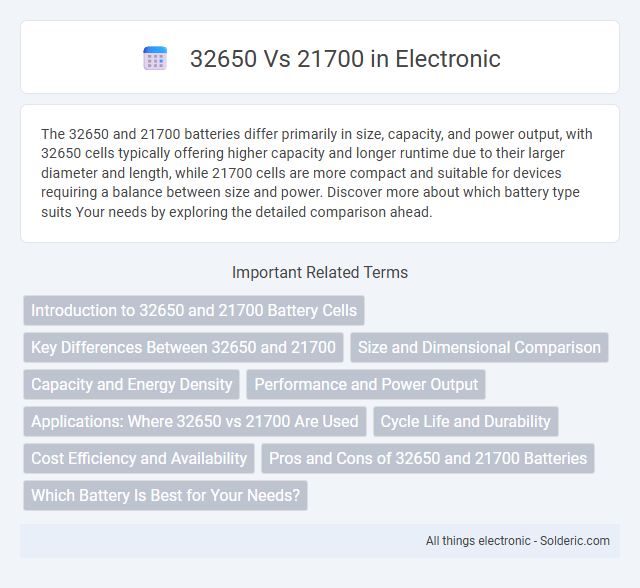The 32650 and 21700 batteries differ primarily in size, capacity, and power output, with 32650 cells typically offering higher capacity and longer runtime due to their larger diameter and length, while 21700 cells are more compact and suitable for devices requiring a balance between size and power. Discover more about which battery type suits Your needs by exploring the detailed comparison ahead.
Comparison Table
| Feature | 32650 Battery | 21700 Battery |
|---|---|---|
| Dimensions (mm) | 32 x 65 | 21 x 70 |
| Capacity (mAh) | 5000 - 6000 | 3000 - 5000 |
| Voltage (Nominal) | 3.6V - 3.7V | 3.6V - 3.7V |
| Max Continuous Discharge (A) | 10 - 20 | 15 - 35 |
| Energy Density | Lower than 21700 | Higher than 32650 |
| Weight (g) | Approx. 90 - 100 | Approx. 60 - 70 |
| Common Usage | High capacity applications, e-bikes, power tools | Electric vehicles, power tools, high drain devices |
Introduction to 32650 and 21700 Battery Cells
The 32650 battery cell measures 32mm in diameter and 65mm in length, offering high capacity and current output suitable for high-drain devices and electric vehicles. The 21700 cell, with dimensions of 21mm diameter and 70mm length, combines compact size and improved energy density, increasingly favored in modern electronics and electric vehicle batteries. Both cells are lithium-ion types, but the 32650 generally provides higher capacity while the 21700 balances efficiency and size for enhanced performance.
Key Differences Between 32650 and 21700
The key differences between 32650 and 21700 lithium-ion batteries lie in their size, capacity, and application. The 32650 battery measures 32mm in diameter and 65mm in length, offering higher capacity typically around 5000-6000mAh, making it suitable for high-drain devices and flashlights. In contrast, the 21700 battery is smaller at 21mm diameter and 70mm length, with capacities ranging from 3000-5000mAh, providing a balance of energy density and compactness favored in electric vehicles and portable electronics.
Size and Dimensional Comparison
The 32650 battery measures approximately 32mm in diameter and 65mm in length, while the 21700 battery has a smaller diameter of 21mm but a longer length of about 70mm. This size difference affects energy density and device compatibility, with the 32650 offering a larger girth suitable for high-capacity applications and the 21700 fitting into more compact spaces with improved energy efficiency. Understanding these dimensional variations is essential for selecting the right battery based on physical constraints and performance requirements.
Capacity and Energy Density
The 32650 battery typically offers a higher capacity, ranging from 5000mAh to 6000mAh, compared to the 21700's 3000mAh to 5000mAh capacity range. In terms of energy density, 21700 cells generally provide superior performance due to their optimized internal chemistry and design, resulting in more energy storage per unit volume. When selecting a battery for your devices, understanding the balance between the larger capacity of the 32650 and the higher energy density of the 21700 is crucial for maximizing efficiency and runtime.
Performance and Power Output
The 21700 battery generally offers higher performance and power output compared to the 32650 cell due to its larger capacity and increased energy density. You can expect more consistent current delivery and longer runtime from a 21700, making it ideal for high-drain devices and applications requiring sustained power. However, the 32650 may provide better thermal management in certain setups due to its larger diameter and thicker casing.
Applications: Where 32650 vs 21700 Are Used
32650 and 21700 batteries are commonly used in different applications due to their size and capacity differences. 32650 batteries, known for their large diameter and high capacity, are often found in high-power flashlights, electric vehicles, and energy storage systems where long runtime and high discharge rates are essential. 21700 batteries, with a more compact size and optimized energy density, are widely used in laptops, power tools, and electric bikes, providing a balance between size, capacity, and performance suitable for your portable and medium-power needs.
Cycle Life and Durability
The 32650 battery offers a robust cycle life typically ranging from 800 to 1500 cycles, making it suitable for applications requiring long durability. In contrast, the 21700 battery often delivers an extended cycle life of up to 3000 cycles, benefiting performance in high-demand devices and electric vehicles. Both cells provide solid durability; however, the 21700's advanced chemistry and design lead to superior longevity under frequent charge-discharge cycles.
Cost Efficiency and Availability
The 21700 battery cells generally offer better cost efficiency due to their higher energy density and improved manufacturing scalability, leading to lower cost per watt-hour compared to the smaller 32650 cells. The 21700 format is more widely available in the market, supported by major manufacturers and popularized by electric vehicle applications, whereas 32650 cells are less common and may result in higher procurement costs and limited sourcing options. Choosing 21700 cells typically ensures a more abundant supply chain and better pricing, making them a preferred choice for large-scale production and consumer electronics.
Pros and Cons of 32650 and 21700 Batteries
32650 batteries offer higher capacity and longer runtimes, making them ideal for devices requiring extended power, but they tend to be bulkier and heavier compared to 21700 cells. 21700 batteries provide a balanced combination of energy density and compact size, enhancing portability and compatibility with a wider range of devices, though they may have slightly lower capacity than 32650 batteries. You should consider your specific device requirements and size constraints when choosing between these two battery types.
Which Battery Is Best for Your Needs?
The 32650 battery offers higher capacity and longer runtime, making it ideal for high-drain devices and applications requiring extended use, such as flashlights and electric tools. The 21700 battery provides a balanced mix of energy density, size, and weight, suitable for portable electronics and electric vehicles where space efficiency and power output are critical. Choosing the best battery depends on whether runtime or compactness and versatility take priority in your specific usage scenario.
32650 vs 21700 Infographic

 solderic.com
solderic.com